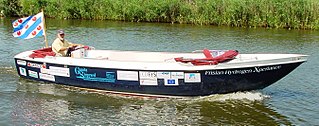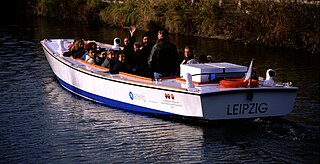
An electric boat is a powered watercraft driven by electric motors, which are powered by either on-board battery packs, solar panels or generators.

A hydrogen vehicle is a vehicle that uses hydrogen fuel for motive power. Hydrogen vehicles include hydrogen-fueled space rockets, as well as ships and aircraft. Motive power is generated by converting the chemical energy of hydrogen to mechanical energy, either by reacting hydrogen with oxygen in a fuel cell to power electric motors or, less commonly, by burning hydrogen in an internal combustion engine.

A water taxi or a water bus is a watercraft used to provide public or private transport, usually, but not always, in an urban environment. Service may be scheduled with multiple stops, operating in a similar manner to a bus, or on demand to many locations, operating in a similar manner to a taxi. A boat service shuttling between two points would normally be described as a ferry rather than a water bus or taxi.

A fuel cell vehicle (FCV) or fuel cell electric vehicle (FCEV) is an electric vehicle that uses a fuel cell, sometimes in combination with a small battery or supercapacitor, to power its onboard electric motor. Fuel cells in vehicles generate electricity generally using oxygen from the air and compressed hydrogen. Most fuel cell vehicles are classified as zero-emissions vehicles that emit only water and heat. As compared with internal combustion vehicles, hydrogen vehicles centralize pollutants at the site of the hydrogen production, where hydrogen is typically derived from reformed natural gas. Transporting and storing hydrogen may also create pollutants. Fuel cells have been used in various kinds of vehicles including forklifts, especially in indoor applications where their clean emissions are important to air quality, and in space applications. Fuel cells are being developed and tested in trucks, buses, boats, ships, motorcycles and bicycles, among other kinds of vehicles.

Eureka is a side-wheel paddle steamboat, built in 1890, which is now preserved at the San Francisco Maritime National Historical Park in San Francisco, California. Originally named Ukiah to commemorate the railway's recent extension into the City of Ukiah, the boat was built by the San Francisco and North Pacific Railroad Company at their Tiburon yard. Eureka has been designated a National Historic Landmark and was listed in the National Register of Historic Places on April 24, 1973.
Air-independent propulsion (AIP), or air-independent power, is any marine propulsion technology that allows a non-nuclear submarine to operate without access to atmospheric oxygen. AIP can augment or replace the diesel-electric propulsion system of non-nuclear vessels.

A hydrogen-powered aircraft is an aeroplane that uses hydrogen fuel as a power source. Hydrogen can either be burned in a jet engine or another kind of internal combustion engine, or can be used to power a fuel cell to generate electricity to power an electric propulsor. It cannot be stored in a traditional wet wing, and hydrogen tanks have to be housed in the fuselage or be supported by the wing.

The Toyota FCHV is a hybrid hydrogen fuel cell vehicle development programme of the Toyota Motor Corporation, which was leased to a limited number of drivers in the United States and Japan beginning in 2002. The Toyota FCHV and Honda FCX, which began leasing on 2 December 2002, became the world's first government-certified commercial hydrogen fuel cell vehicles. Its first commercial fuel cell vehicle was developed from the FCHV-4, which was adapted from the Toyota Highlander body. "FCHV" stands for "Fuel Cell Hybrid Vehicle". A number of prototypes have been produced, up to the latest FCHV-adv ("advanced").
The Honda FCX is a family of hydrogen fuel cell automobiles manufactured by Honda.
The project Zemships developed the FCS Alsterwasser, a 100 person hydrogen-power passenger ship, power-assisted by an electric motor that gets its electricity from a fuel cell. The first boat operates on the Alster in Hamburg since 2008. The keel laying at the SSB shipyard in Oortkaten was on 4 December 2007.
A Tuckerboot on hydrogen is an 8-person ship, power-assisted by an electric motor that gets its electricity from a fuel cell. Two boats are operating in Hamburg. The design is based on the AMS Tuckerboot 675.

The Xperiance NX hydrogen is a 12-person hydrogen ship, power-assisted by an electric motor that gets its electricity from a fuel cell. The debut was on 23 June 2006 at Leeuwarden, Netherlands.

The Hydra is a 22-person hydrogen boat, power-assisted by an electric motor that gets its electricity from a fuel cell. Its debut was in June 2000 on the Rhine near Bonn, Germany.
No. 1 is the name of a sailing yacht which is power-assisted by an electric motor that gets its electricity from hydrogen fuel cells. It is the first ever yacht to be fuel cell-powered. The boat was certified under the Germanischer Lloyd guidelines for fuel cells on ships and boats. The yacht's debut was in August 2003 in Japan, and it is commissioned at Lake Constance.
A hydrogen ship is a hydrogen fueled ship, power-assisted by an electric motor that gets its electricity from a fuel cell. Or uses hydrogen fuel in an internal combustion engine.

A fuel cell bus is a bus that uses a hydrogen fuel cell as its power source for electrically driven wheels, sometimes augmented in a hybrid fashion with batteries or a supercapacitor. The only emission from the bus is water. Several cities around the world have trialled and tested fuel cell buses, with over 5,600 buses in use worldwide, the majority of which are in China.
The Hornblower Hybrid is a family of ferry boats belonging to US operator Hornblower Cruises, which are powered with hybrid power trains.

SunLine Transit Agency, a transit operator in Riverside County, California, is a transit agency providing bus service in the Palm Springs Area, with service extending into San Bernardino Transit Center during peak hours. In 2022, the system had a ridership of 2,518,000, or about 8,700 per weekday as of the first quarter of 2023.
The Nemo H2 is a passenger ship developed by Fuel Cell Boat for 88 people in Amsterdam for which the power for the electric motor is generated by a fuel cell on hydrogen. It is the first boat for 88 people in the Netherlands with a fuel cell. The keel laying was in Hasselt in 2008 and the first boat is in operation on the canals in Amsterdam since December 2009.

The New Flyer Xcelsior is a line of transit buses available in 35-foot rigid, 40-foot rigid, and 60-foot articulated nominal lengths manufactured by New Flyer Industries since 2008. In addition to the different available lengths, the buses are sold with a variety of propulsion systems: conventional diesel, compressed natural gas (CNG), diesel-electric hybrid, hydrogen fuel cell, overhead electric wire and battery electric. A future autonomous bus variant was announced in January 2021.












